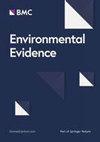Collating existing evidence on cumulative impacts of invasive plant species in riparian ecosystems of British Columbia, Canada: a systematic map protocol
IF 5.2
4区 环境科学与生态学
Q2 ENVIRONMENTAL SCIENCES
引用次数: 0
Abstract
Globally, the structure and functioning of foreshore and riparian ecosystems are being dramatically impacted by non-native invasive plant species. Invasive species can outcompete and replace native species, modify geochemical and hydraulic cycles, alter trophic processes, and change the composition and structure of communities above and below ground. However, these impacts are often investigated in isolation, even though one invasive species might increase or mitigate the impacts of others (i.e. cumulative impacts), potentially with cascading effects. Although cumulative impacts have long been studied within other environmental contexts, research on the cumulative impacts of invasive species is comparatively scarce. We aim to develop a protocol to systematically identify and collate evidence on the individual and cumulative impacts of a set of plant species invasive in foreshore and riparian ecosystems of British Columbia, Canada. Our primary question is: what evidence is available on the individual and cumulative impacts of invasive plants in the riparian and foreshore ecosystems of British Columbia, Canada? In addition, our systematic map will identify the strengths and gaps in knowledge pertaining to invasive plant species impacts in foreshore and riparian ecosystems, with the ultimate goal of facilitating the development of evidence-based management strategies. We identified the research topic and the primary and secondary questions with the support of stakeholders. We then devised a flexible string that allows for searching target invasive species. Using this string, we searched the literature for pilot species that aided the iterative development of the protocol. Once all target species are identified, we will carry out a systematic literature search on their impacts. We will search Web of Science and the CABI compendium for invasive species. We will include studies if they (i) refer to the target invasive species, (ii) focus on its environmental impacts and (iii) investigate such impacts in riparian ecosystems (iv) within North America (i.e. Canada and U.S.A.). We will use a two-stage screening process: titles and abstracts first, then the full manuscript. From each source, we will extract impact description, ecosystem component impacted, and magnitude and directionality of impacts. We will include a publicly available database of studies, descriptive statistics, and a narrative summary within our synthesis outcomes.整理加拿大不列颠哥伦比亚省河岸生态系统中入侵植物物种累积影响的现有证据:系统地图协议
在全球范围内,前滨和河岸生态系统的结构和功能正受到外来入侵植物物种的巨大影响。入侵物种可以超越和取代本地物种,改变地球化学和水力循环,改变营养过程,改变地上和地下群落的组成和结构。然而,这些影响往往是孤立地进行调查的,即使一个入侵物种可能增加或减轻其他物种的影响(即累积影响),可能具有级联效应。虽然在其他环境背景下对累积影响进行了长期的研究,但对入侵物种累积影响的研究相对较少。我们的目标是制定一项协议,系统地识别和整理一组植物物种入侵对加拿大不列颠哥伦比亚省前海岸和河岸生态系统的个体和累积影响的证据。我们的主要问题是:有什么证据可以证明入侵植物对加拿大不列颠哥伦比亚省的河岸和前海岸生态系统的个体和累积影响?此外,我们的系统地图将确定与入侵植物物种对前滨和河岸生态系统影响有关的知识优势和差距,最终目标是促进循证管理策略的发展。我们在利益相关者的支持下确定了研究主题和主要和次要问题。然后,我们设计了一个灵活的字符串,允许搜索目标入侵物种。使用这个字符串,我们搜索了文献的试点物种,帮助迭代发展的协议。一旦确定了所有目标物种,我们将对其影响进行系统的文献检索。我们将在Web of Science和CABI纲要中搜索入侵物种。我们将包括以下研究:(i)涉及目标入侵物种,(ii)关注其环境影响,(iii)调查其对河岸生态系统的影响(iv)在北美(即加拿大和美国)。我们将采用两阶段筛选流程:首先是标题和摘要,然后是全文。从每个来源中,我们将提取影响描述、受影响的生态系统成分以及影响的大小和方向性。我们将在我们的综合结果中包括一个公开的研究数据库、描述性统计数据和叙述性总结。
本文章由计算机程序翻译,如有差异,请以英文原文为准。
求助全文
约1分钟内获得全文
求助全文
来源期刊

Environmental Evidence
Environmental Science-Management, Monitoring, Policy and Law
CiteScore
6.10
自引率
18.20%
发文量
36
审稿时长
17 weeks
期刊介绍:
Environmental Evidence is the journal of the Collaboration for Environmental Evidence (CEE). The Journal facilitates rapid publication of evidence syntheses, in the form of Systematic Reviews and Maps conducted to CEE Guidelines and Standards. We focus on the effectiveness of environmental management interventions and the impact of human activities on the environment. Our scope covers all forms of environmental management and human impacts and therefore spans the natural and social sciences. Subjects include water security, agriculture, food security, forestry, fisheries, natural resource management, biodiversity conservation, climate change, ecosystem services, pollution, invasive species, environment and human wellbeing, sustainable energy use, soil management, environmental legislation, environmental education.
 求助内容:
求助内容: 应助结果提醒方式:
应助结果提醒方式:


